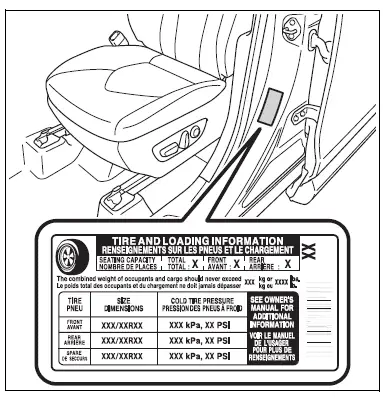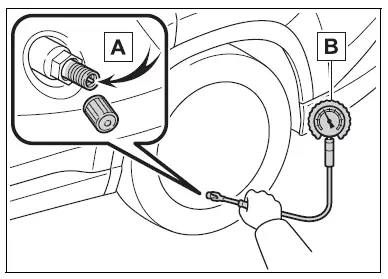Toyota Grand Highlander (AS10) 2024 Owners Manual / Maintenance and care / Tire inflation pressure
Toyota Grand Highlander (AS10): Tire inflation pressure
Checking the specified tire inflation pressure
The recommended cold tire inflation pressure and tire size are displayed on the tire and loading information label.

Inspection and adjustment procedure

- Tire valve
- Tire pressure gauge
1. Remove the tire valve cap.
2. Press the tip of the tire pressure gauge onto the tire valve.
3. Read the pressure using the gauge gradations.
4. If the tire inflation pressure is not at the recommended level, adjust the pressure.
If you add too much air, press the center of the valve to deflate.
5. After completing the tire inflation pressure measurement and adjustment, apply soapy water to the valve and check for leakage.
6. Put the tire valve cap back on.
■Tire inflation pressure check interval
You should check tire inflation pressure every two weeks, or at least once a month. Do not forget to check the spare.
■Effects of incorrect tire inflation pressure
Driving with incorrect tire inflation pressure may result in the following:
- Reduced fuel economy
- Reduced driving comfort and poor handling
- Reduced tire life due to wear
- Reduced safety
- Damage to the drive train
If a tire needs frequent inflating, have it checked by your Toyota dealer.
■Instructions for checking tire inflation pressure
When checking tire inflation pressure pressure, observe the following:
- Check only when the tires are
cold.
If your vehicle has been parked for at least 3 hours or has not been driven for more than 1 mile or 1.5 km, you will get an accurate cold tire inflation pressure reading.
- Always use a tire pressure gauge.
It is difficult to judge if a tire is properly inflated based only on its appearance.
- It is normal for the tire inflation pressure to be higher after driving as heat is generated in the tire. Do not reduce tire inflation pressure after driving.
- Never exceed the vehicle capacity
weight.
Passengers and luggage weight should be placed so that the vehicle is balanced.
WARNING
■Proper inflation is critical to save tire performance
Keep your tires properly inflated.
If the tires are not properly inflated, the following conditions may occur which could lead to an accident resulting in death or serious injury:
- Excessive wear
- Uneven wear
- Poor handling
- Possibility of blowouts resulting from overheated tires
- Air leaking from between tire and wheel
- Wheel deformation and/or tire damage
- Greater possibility of tire damage while driving (due to road hazards, expansion joints, sharp edges in the road, etc.)
NOTICE
■When inspecting and adjusting tire inflation pressure
Be sure to put the tire valve caps back on.
If a valve cap is not installed, dirt or moisture may get into the valve and cause an air leak, resulting in decreased tire inflation pressure.
Similar pages:
Parking Support Brake function
(static objects front and rear of
the vehicle)
If the sensors detect a static
object, such as a wall, in the
traveling direction of the
vehicle and the system
determines that a collision
may occur due to the vehicle
suddenly moving forward
due to an accidental
accelerator pedal operation,
the vehicle moving the
unintended direction due to
the wr ...
If the engine will not start
If the engine will not start
even though correct starting
procedures are being followed, consider
each of the following points:
The engine will not start
even though the starter
motor operates normally.
One of the following may be the
cause of the problem:
There may not be sufficient
fuel in the ...


